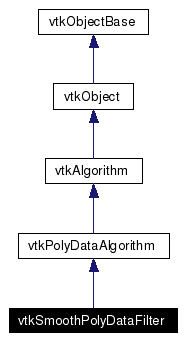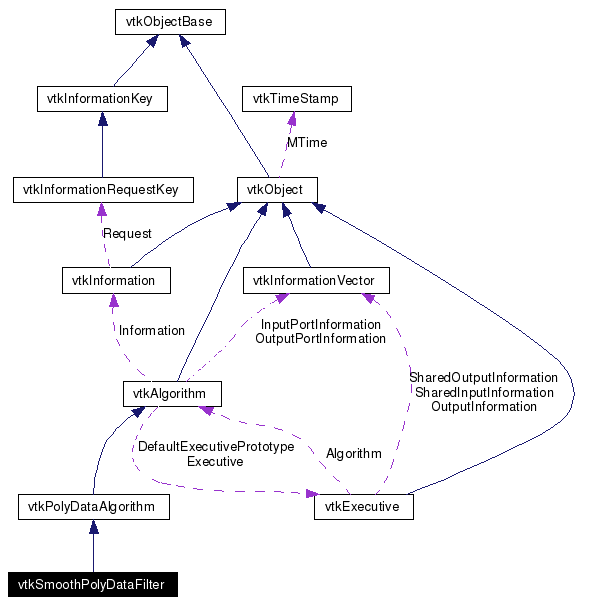vtkSmoothPolyDataFilter Class Reference
#include <vtkSmoothPolyDataFilter.h>
Inheritance diagram for vtkSmoothPolyDataFilter:
 [legend]Collaboration diagram for vtkSmoothPolyDataFilter:
[legend]Collaboration diagram for vtkSmoothPolyDataFilter: [legend]List of all members.
[legend]List of all members.
Detailed Description
adjust point positions using Laplacian smoothing
vtkSmoothPolyDataFilter is a filter that adjusts point coordinates using Laplacian smoothing. The effect is to "relax" the mesh, making the cells better shaped and the vertices more evenly distributed. Note that this filter operates on the lines, polygons, and triangle strips composing an instance of vtkPolyData. Vertex or poly-vertex cells are never modified.
The algorithm proceeds as follows. For each vertex v, a topological and geometric analysis is performed to determine which vertices are connected to v, and which cells are connected to v. Then, a connectivity array is constructed for each vertex. (The connectivity array is a list of lists of vertices that directly attach to each vertex.) Next, an iteration phase begins over all vertices. For each vertex v, the coordinates of v are modified according to an average of the connected vertices. (A relaxation factor is available to control the amount of displacement of v). The process repeats for each vertex. This pass over the list of vertices is a single iteration. Many iterations (generally around 20 or so) are repeated until the desired result is obtained.
There are some special instance variables used to control the execution of this filter. (These ivars basically control what vertices can be smoothed, and the creation of the connectivity array.) The BoundarySmoothing ivar enables/disables the smoothing operation on vertices that are on the "boundary" of the mesh. A boundary vertex is one that is surrounded by a semi-cycle of polygons (or used by a single line).
Another important ivar is FeatureEdgeSmoothing. If this ivar is enabled, then interior vertices are classified as either "simple", "interior edge", or "fixed", and smoothed differently. (Interior vertices are manifold vertices surrounded by a cycle of polygons; or used by two line cells.) The classification is based on the number of feature edges attached to v. A feature edge occurs when the angle between the two surface normals of a polygon sharing an edge is greater than the FeatureAngle ivar. Then, vertices used by no feature edges are classified "simple", vertices used by exactly two feature edges are classified "interior edge", and all others are "fixed" vertices.
Once the classification is known, the vertices are smoothed differently. Corner (i.e., fixed) vertices are not smoothed at all. Simple vertices are smoothed as before (i.e., average of connected vertex coordinates). Interior edge vertices are smoothed only along their two connected edges, and only if the angle between the edges is less than the EdgeAngle ivar.
The total smoothing can be controlled by using two ivars. The NumberOfIterations is a cap on the maximum number of smoothing passes. The Convergence ivar is a limit on the maximum point motion. If the maximum motion during an iteration is less than Convergence, then the smoothing process terminates. (Convergence is expressed as a fraction of the diagonal of the bounding box.)
There are two instance variables that control the generation of error data. If the ivar GenerateErrorScalars is on, then a scalar value indicating the distance of each vertex from its original position is computed. If the ivar GenerateErrorVectors is on, then a vector representing change in position is computed.
Optionally you can further control the smoothing process by defining a second input: the Source. If defined, the input mesh is constrained to lie on the surface defined by the Source ivar.
- Warning:
- The Laplacian operation reduces high frequency information in the geometry of the mesh. With excessive smoothing important details may be lost, and the surface may shrink towards the centroid. Enabling FeatureEdgeSmoothing helps reduce this effect, but cannot entirely eliminate it. You may also wish to try vtkWindowedSincPolyDataFilter. It does a better job of minimizing shrinkage.
- See also:
- vtkWindowedSincPolyDataFilter vtkDecimate vtkDecimatePro
- Examples:
- vtkSmoothPolyDataFilter (Examples)
- Tests:
- vtkSmoothPolyDataFilter (Tests)
Definition at line 105 of file vtkSmoothPolyDataFilter.h.
Member Typedef Documentation
Constructor & Destructor Documentation
| vtkSmoothPolyDataFilter::vtkSmoothPolyDataFilter |
( |
|
) |
[protected] |
|
| vtkSmoothPolyDataFilter::~vtkSmoothPolyDataFilter |
( |
|
) |
[inline, protected] |
|
Member Function Documentation
| virtual const char* vtkSmoothPolyDataFilter::GetClassName |
( |
|
) |
[virtual] |
|
| static int vtkSmoothPolyDataFilter::IsTypeOf |
( |
const char * |
type |
) |
[static] |
|
|
|
Return 1 if this class type is the same type of (or a subclass of) the named class. Returns 0 otherwise. This method works in combination with vtkTypeRevisionMacro found in vtkSetGet.h.
Reimplemented from vtkPolyDataAlgorithm. |
| virtual int vtkSmoothPolyDataFilter::IsA |
( |
const char * |
type |
) |
[virtual] |
|
|
|
Return 1 if this class is the same type of (or a subclass of) the named class. Returns 0 otherwise. This method works in combination with vtkTypeRevisionMacro found in vtkSetGet.h.
Reimplemented from vtkPolyDataAlgorithm. |
| void vtkSmoothPolyDataFilter::PrintSelf |
( |
ostream & |
os, |
|
|
vtkIndent |
indent |
|
) |
[virtual] |
|
|
|
Methods invoked by print to print information about the object including superclasses. Typically not called by the user (use Print() instead) but used in the hierarchical print process to combine the output of several classes.
Reimplemented from vtkPolyDataAlgorithm. |
|
|
Construct object with number of iterations 20; relaxation factor .01; feature edge smoothing turned off; feature angle 45 degrees; edge angle 15 degrees; and boundary smoothing turned on. Error scalars and vectors are not generated (by default). The convergence criterion is 0.0 of the bounding box diagonal.
Reimplemented from vtkPolyDataAlgorithm. |
| virtual void vtkSmoothPolyDataFilter::SetConvergence |
( |
double |
|
) |
[virtual] |
|
|
|
Specify a convergence criterion for the iteration process. Smaller numbers result in more smoothing iterations. |
| virtual double vtkSmoothPolyDataFilter::GetConvergence |
( |
|
) |
[virtual] |
|
|
|
Specify a convergence criterion for the iteration process. Smaller numbers result in more smoothing iterations. |
| virtual void vtkSmoothPolyDataFilter::SetNumberOfIterations |
( |
int |
|
) |
[virtual] |
|
|
|
Specify the number of iterations for Laplacian smoothing, |
| virtual int vtkSmoothPolyDataFilter::GetNumberOfIterations |
( |
|
) |
[virtual] |
|
|
|
Specify the number of iterations for Laplacian smoothing, |
| virtual void vtkSmoothPolyDataFilter::SetRelaxationFactor |
( |
double |
|
) |
[virtual] |
|
|
|
Specify the relaxation factor for Laplacian smoothing. As in all iterative methods, the stability of the process is sensitive to this parameter. In general, small relaxation factors and large numbers of iterations are more stable than larger relaxation factors and smaller numbers of iterations. |
| virtual double vtkSmoothPolyDataFilter::GetRelaxationFactor |
( |
|
) |
[virtual] |
|
|
|
Specify the relaxation factor for Laplacian smoothing. As in all iterative methods, the stability of the process is sensitive to this parameter. In general, small relaxation factors and large numbers of iterations are more stable than larger relaxation factors and smaller numbers of iterations. |
| virtual void vtkSmoothPolyDataFilter::SetFeatureEdgeSmoothing |
( |
int |
|
) |
[virtual] |
|
|
|
Turn on/off smoothing along sharp interior edges. |
| virtual int vtkSmoothPolyDataFilter::GetFeatureEdgeSmoothing |
( |
|
) |
[virtual] |
|
|
|
Turn on/off smoothing along sharp interior edges. |
| virtual void vtkSmoothPolyDataFilter::FeatureEdgeSmoothingOn |
( |
|
) |
[virtual] |
|
|
|
Turn on/off smoothing along sharp interior edges. |
| virtual void vtkSmoothPolyDataFilter::FeatureEdgeSmoothingOff |
( |
|
) |
[virtual] |
|
|
|
Turn on/off smoothing along sharp interior edges. |
| virtual void vtkSmoothPolyDataFilter::SetFeatureAngle |
( |
double |
|
) |
[virtual] |
|
|
|
Specify the feature angle for sharp edge identification. |
| virtual double vtkSmoothPolyDataFilter::GetFeatureAngle |
( |
|
) |
[virtual] |
|
|
|
Specify the feature angle for sharp edge identification. |
| virtual void vtkSmoothPolyDataFilter::SetEdgeAngle |
( |
double |
|
) |
[virtual] |
|
|
|
Specify the edge angle to control smoothing along edges (either interior or boundary). |
| virtual double vtkSmoothPolyDataFilter::GetEdgeAngle |
( |
|
) |
[virtual] |
|
|
|
Specify the edge angle to control smoothing along edges (either interior or boundary). |
| virtual void vtkSmoothPolyDataFilter::SetBoundarySmoothing |
( |
int |
|
) |
[virtual] |
|
|
|
Turn on/off the smoothing of vertices on the boundary of the mesh. |
| virtual int vtkSmoothPolyDataFilter::GetBoundarySmoothing |
( |
|
) |
[virtual] |
|
|
|
Turn on/off the smoothing of vertices on the boundary of the mesh. |
| virtual void vtkSmoothPolyDataFilter::BoundarySmoothingOn |
( |
|
) |
[virtual] |
|
|
|
Turn on/off the smoothing of vertices on the boundary of the mesh. |
| virtual void vtkSmoothPolyDataFilter::BoundarySmoothingOff |
( |
|
) |
[virtual] |
|
|
|
Turn on/off the smoothing of vertices on the boundary of the mesh. |
| virtual void vtkSmoothPolyDataFilter::SetGenerateErrorScalars |
( |
int |
|
) |
[virtual] |
|
|
|
Turn on/off the generation of scalar distance values. |
| virtual int vtkSmoothPolyDataFilter::GetGenerateErrorScalars |
( |
|
) |
[virtual] |
|
|
|
Turn on/off the generation of scalar distance values. |
| virtual void vtkSmoothPolyDataFilter::GenerateErrorScalarsOn |
( |
|
) |
[virtual] |
|
|
|
Turn on/off the generation of scalar distance values. |
| virtual void vtkSmoothPolyDataFilter::GenerateErrorScalarsOff |
( |
|
) |
[virtual] |
|
|
|
Turn on/off the generation of scalar distance values. |
| virtual void vtkSmoothPolyDataFilter::SetGenerateErrorVectors |
( |
int |
|
) |
[virtual] |
|
|
|
Turn on/off the generation of error vectors. |
| virtual int vtkSmoothPolyDataFilter::GetGenerateErrorVectors |
( |
|
) |
[virtual] |
|
|
|
Turn on/off the generation of error vectors. |
| virtual void vtkSmoothPolyDataFilter::GenerateErrorVectorsOn |
( |
|
) |
[virtual] |
|
|
|
Turn on/off the generation of error vectors. |
| virtual void vtkSmoothPolyDataFilter::GenerateErrorVectorsOff |
( |
|
) |
[virtual] |
|
|
|
Turn on/off the generation of error vectors. |
| void vtkSmoothPolyDataFilter::SetSource |
( |
vtkPolyData * |
source |
) |
|
|
|
|
Specify the source object which is used to constrain smoothing. The source defines a surface that the input (as it is smoothed) is constrained to lie upon. |
|
|
Specify the source object which is used to constrain smoothing. The source defines a surface that the input (as it is smoothed) is constrained to lie upon. |
|
|
This is called by the superclass. This is the method you should override.
Reimplemented from vtkPolyDataAlgorithm. |
| virtual int vtkSmoothPolyDataFilter::FillInputPortInformation |
( |
int |
port, |
|
|
vtkInformation * |
info |
|
) |
[protected, virtual] |
|
|
|
Fill the input port information objects for this algorithm. This is invoked by the first call to GetInputPortInformation for each port so subclasses can specify what they can handle.
Reimplemented from vtkPolyDataAlgorithm. |
Member Data Documentation
The documentation for this class was generated from the following file:
Generated on Tue Jan 22 00:17:09 2008 for VTK by
 1.4.3-20050530
1.4.3-20050530



 1.4.3-20050530
1.4.3-20050530